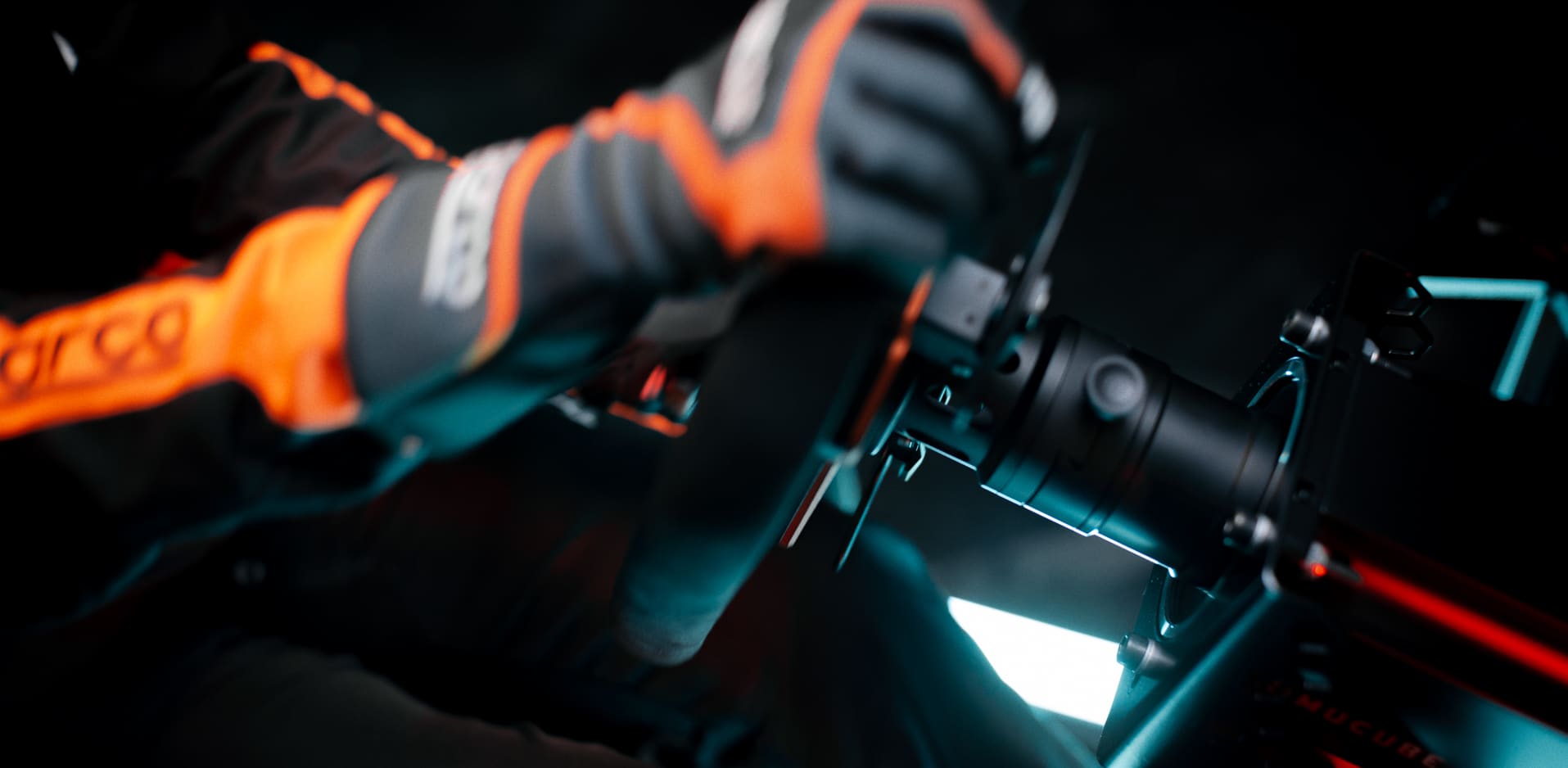All you need to know about an ultimate sim racing setup

You’ve decided you’re ready to step up into a professional-grade sim rig, AWESOME!
In this article, we’re going to dive into the world of simulation and help you prioritize what’s most important when choosing the right gear to suit your needs and budget.
The first important point to cover is that contrary to what may seem logical, the wheelbase itself isn’t the essential factor in driving quickly and consistently. That might sound a bit counterintuitive as the wheelbase provides most of the feedback to the driver. While a good quality wheel will add extra detail and help you to feel what’s going on with the car more precisely, at the higher end, it is more about precision, consistency, and of course, immersion. That said, the ultimate goal of any simulation is to create the most life-like experience possible, so if a more realistic sim racing experience is what you’re after, then you’re in the right place.
High-quality pedals, for example Heusinkveld Ultimate, and a solid flex-free mounting solution like Simucube Mount, will have a large impact on your speed and consistency. A solid mounting solution is also essential to ensure that all the details from your wheelbase are transmitted through to your hands, with no dampening from flex in the mount.
All Simucube 2 wheelbases feature an auxiliary input that supports the direct connection of supported pedals at 16-bit resolution, without an additional USB connection.
The reason why pedals and a solid rig impact speed and consistency comes down to muscle memory. To put it simply, your brain is very good at adapting to the inputs that it’s presented with. As long as the inputs are consistent and as long as the feeling that you’re getting through the wheel is consistent every time you approach the limit of grip, your brain will recognize this as a cue and begin to react instinctively.
While upgrading to more expensive pedals often gives you a more extensive range of control as an input device. To a large extent, a wheelbase is just a wheelbase in terms of how it interprets your physical inputs and then feeds them back to the game or sim. Again, what’s important is that what you are feeling and reacting to is consistent. This allows us to develop muscle memory and form routines that allow us to react in real-time instinctively. The more we can “feel” and the less we’re relying on what we see on the screen, the more precise we will be. Real-life racing drivers, such as Lewis Hamilton, have commented that you react to what you’re feeling in a car before what you’re seeing.
So now, let’s look at the various design factors that will influence how different wheelbases will feel.
In terms of hardware, there are three main factors that combine along with the software. These factors influence how a wheel will feel and perform in terms of both, the fidelity and the overall torque delivery or power delivery that you feel through your hands.
Cog/Wheel Driven Wheelbases
The approaches taken to these systems slightly vary between different manufacturers and models. Generally speaking, these systems use a series of gears to increase the strength of the feedback that you feel in lieu of a motor with more physical torque. This works much like gearing inside a car; the wheel turns slower but with more torque relative to the speed of the motor itself. It is like putting your car in first gear; it has more torque to move more quickly, but the wheel doesn’t turn as fast.
This does work quite well and it certainly keeps the production costs down, hence why it’s most often found in the more entry-level hardware. However, this approach does have its limitations which manifest in a few different ways. Firstly, they tend to be noisier than the Direct Drive belt-driven counterparts simply due to the unavoidable sound generated by the gears physically interfacing with each other.
Because gearing is used to increase torque delivery, belt-driven wheelbases also have limitations in how quickly they can rotate independently.
Under normal circumstances, most real-life cars (even those without power steering) don’t exceed around 7-12 Newton Meters of torque through the steering under usual driving conditions. It can exceed that if you were to crash into a wall and the steering suddenly jerked, which is why you see racing drivers let go of the steering wheel when they’re out of control. By comparison, the geared type force feedback steering wheels currently on the market offer generally between about 2 and 3 Newton meters of peak torque, so even at full strength, they’re not going to be able to reproduce the same levels of forces that you’d experience beating around a track in a real car.
In summary, regarding gear and cog-driven wheelbases, these are proven to provide excellent value for money, and they’ll give you all the necessary input to be competitive at least. However, they don’t come close to the level of immersion realism that you get with a belt-driven and Direct Drive wheelbase.
Belt Driven Wheelbases
These are the next step up in terms of fidelity and torque, but this comes at a higher price point. Similar to gear-driven wheelbases, belt-driven use a lower torque motor than a Direct Drive wheelbase and have some gearbox to increase the toque delivery at the wheel itself.
Rather than using physical gears that interface directly with each other, they either use a tooth or a ribbed belt and gears to get the job done. These generally feel smoother than cog-driven wheelbases; however, it does introduce what can best be described as a dampening effect caused by the elasticity in the belt itself. This reduces the overall fidelity in what you feel through the steering wheel compared to a Direct Drive wheelbase. For example, road textures feel less defined and a little less real; sharp changes in direction and understeer can feel a little bit smoother than they perhaps should.

The Role of Software
Before we move on to Direct Drive, let’s take a moment to talk about software.
People often get caught up in the numbers, particularly when it comes to Direct Drive. It’s easy to focus on the peak torque because it’s a finite number that is very easily marketable and easy to compare across different makes and models. However, just because one wheelbase has a more powerful motor than another does not automatically mean that it’s going to feel better or offer more fidelity. The motor has a straightforward job, and that is to do what it’s told. It is the responsibility of the firmware, drivers, and software to translate the feedback information coming from the sim title itself into what you ultimately feel through the wheel. This is done through an array of complex filtering and signal interpolation. The quality of the software and firmware engineering is just as important as the quality and engineering of the hardware.
Direct Drive Wheelbases
When it comes to Direct Drive wheelbases, the motor is directly connected to the steering wheel that you’re holding, meaning that you’re feeling absolutely everything that the engine does, including the characteristics of the rotation of the motor itself. So, you can imagine, regardless of the strength of the feedback, if the motor is acting up or has an inherently notchy or grainy feel, then the feedback is also going to feel bad, and this essentially boils down to how well the software and firmware are controlling the motor itself. Don’t underestimate the importance of well-defined software as well as having well-adjusted settings. Resolution and interface data rate are also important factors, as they’ll influence how quickly the wheelbase can react to changes in the game for a smooth output. They will as well be relaying information like positional feedback from what you’re doing into the game for smooth and fast input with no input lag.
In terms of hardware, besides the overall motor strength, Direct Drive wheelbases come in a few different flavors depending on how much you’re prepared to spend. Most manufacturers list the type of motor that they use. Each motor type has its characteristics which influence how they feel.
All Simucube 2 wheelbases use servo motors which are generally regarded as the best type of motor to use for sim racing due to their efficiency and ability to maintain high torque at higher rotational speeds.
Servo stepper motors feature a higher pole count than you’d typically find in a conventional stepper motor and include a position sensor to operate in a closed loop. Hence, the software always knows the current position of the steering wheel. Stepper motors, by definition, operate in an open-loop and don’t have any form of positional feedback. Due to their higher pole count, hybrid servo stepper motors produce a higher amount of torque at low speeds and are relatively cheap to manufacture, which makes them quite compelling for cheaper wheelbases. However, at higher speeds, they can lose up to 80% of their torque. By comparison, a servo motor, as used in the more expensive Direct Drive wheelbases, are able to produce high levels of torque at high speeds. They also operate at a much higher efficiency, therefore, producing less heat.
Both, hybrid servo stepper motors and servo motors, are susceptible to what’s referred to as a cogging or detent effect. This is where the strength of the electromagnetic field varies slightly between the teeth of the rotor and the stator, depending on their relative position. This creates what’s known as torque ripples or slight variations in the torque as the motor rotates. This effect, along with phase imbalance, produces the underlying notchy characteristics that are present in some Direct Drive wheelbases.
The Holy Grail is for your wheel to feel as much like the wheel in a real car as possible. More expensive motors with complex feedback systems and higher precision internals can minimize this effect in varying degrees to the point where it’s quite literally unnoticeable in the Simucube 2 Ultimate.

Simucube





